A Walking Tour of Sculptures On and Around Columbia's Morningside Campus
From Low Library to Barnard to Baker Athletics Complex, here's an introduction to a handful of artful sculptures you can find on Columbia's campuses.

Last year, Columbia News took you on a walking tour of Columbia's Morningside Heights campus. This year, we're putting our artistic hats on and taking you on a walking tour of a handful of sculptures on and around campus. If you're new to the area or decidedly a veteran of the campus, learn a little more about these sculptures to delve deeper into the history of art on campus.
1. Start at Alma Mater
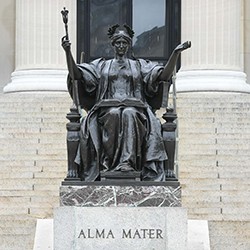
You've seen it. You love it. Alma Mater is an icon. This sculpture is also the perfect place to orient yourself for a short walking tour of a handful of Columbia's artful collections of outdoor sculptures. Located smack-dab in the middle of the Morningside campus, Alma is in front of Low Library.
Donated by Robert Goelet of the Class of 1860 in honor of his wife and son, Alma Mater was designed by Daniel Chester French and cast in bronze by John Williams. "From the time of its installation, this sculpture has been a symbol of academic pride for Columbia University," writes Roberto C. Ferrari, Curator of Art Properties.
A fun fact you may not know about Alma: "The bronze sculpture was initially gilded and thus glowed like a gold beacon in the sunlight," wrote Ferrari.
2. The Thinker (Le Penseur)
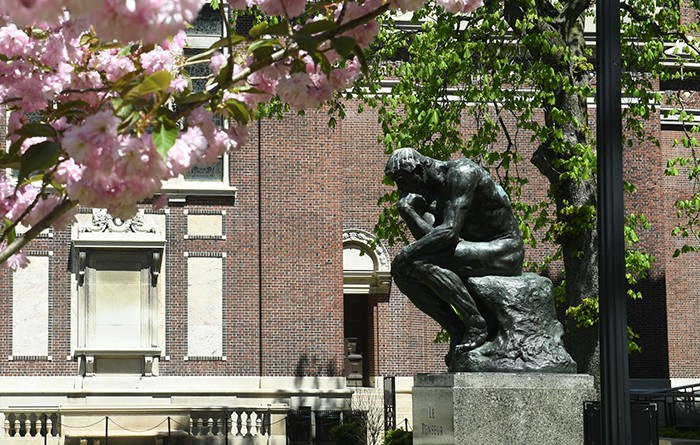
From Alma Mater, take the staircase to the right of Low Steps, walk past Kent Hall on your right and pause at Philosophy Hall, where on your left you can take in Auguste Rodin's (1840-1917) iconic Thinker (Le Penseur) sculpture. The process of acquiring the sculpture began in 1929 under the administration of Nicholas Murray Butler, who was President of Columbia for 44 years, in a continuing effort to beautify the campus, according to Art Properties.
The Thinker was installed in early 1931 in front of Philosophy Hall to balance with The Hammersmith outside the School of Mines, now Columbia Engineering, which was in Lewisohn Hall at the time. The bronze sculpture brings to the fore ideas of deep thought and contemplation, and was originally commissioned in 1880 as part of The Gates of Hell, a reference to Dante's The Divine Comedy. There are 27 other known full-size castings in the world.
"We should then have two of the masterpieces of the two greatest modern sculptors on our quadrangle," Butler is quoted as saying about The Thinker and Le Marteleur (The Hammersmith).
3. Head up to Revson Plaza
As you continue forward and up the steps to the right of Philosophy Hall, you will emerge on Revson Plaza, the bridge that overlooks Amsterdam Avenue. Once there, walk straight ahead and look to your left.
3a. Life Force
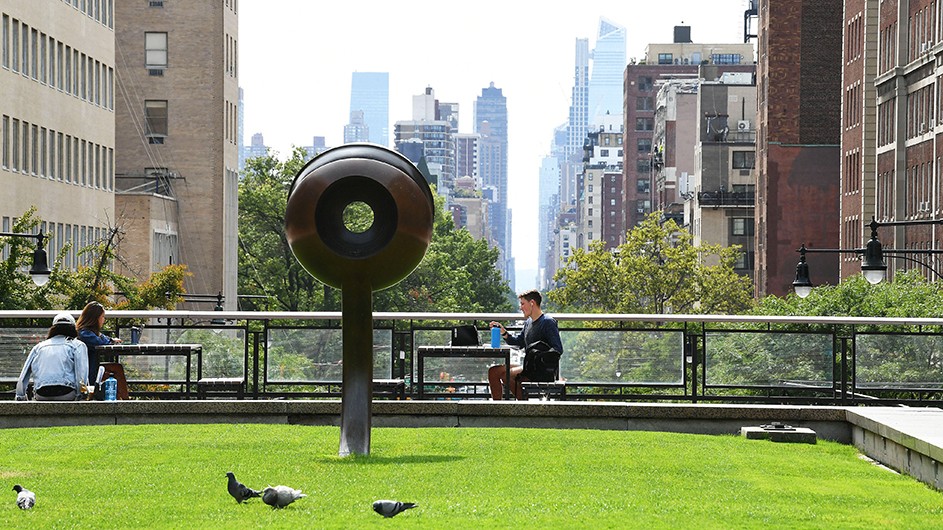
In July of 1992, Columbia installed a bronze work called Life Force by the Boston sculptor David Bakalar, a physicist who worked in electronics before becoming a sculptor whose work focused on the relationship between humans and science. He defined the theme of "life force" in an exhibition pamphlet as including "the mating forces, the birth force, death force, competitive force, nurturant force..."
This sculpture was the gift of an anonymous donor in 1992 to honor the memory of Ruth Goldman Schapiro, Columbia Law School, Class of 1950.
3b. Bellerophon Taming Pegasus
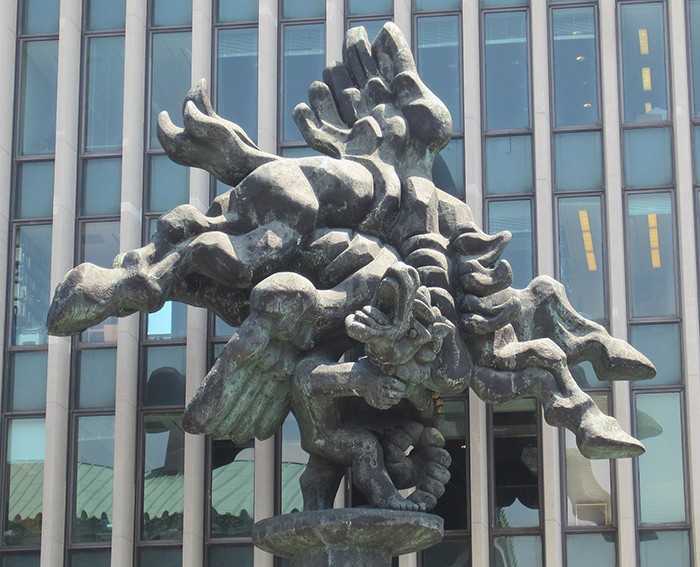
After taking in Life Force, look up and to your right where Jacques Lipchitz's Bellerophon Taming Pegasus stands above an entrance to Columbia Law School. While at first you may wonder what is going on, the sculpture is an illustration of a moment in Greek mythology: When Bellerophon captures Pegasus, symbolizing man's triumph over nature and the imposition of law upon the world.
The sculpture was created in 1967 by Jacques Lipchitz (1891-1973), a Lithuanian sculptor who was a leader in the cubist movement. The sculpture was a commission from the artist and a gift from alumni of the Law School to celebrate their new building. The sculpture was shipped from Italy by boat in multiple parts and constructed and installed in 1977 onto the building.
Here's a fun fact to pull out at your next party: After the Statue of Liberty, Columbia's Bellerophon Taming Pegasus is still regarded as the second-largest metal sculpture in New York City (!!). It is 57 feet tall, including its stand.
3c. Three-Way Piece, No. 1: Points
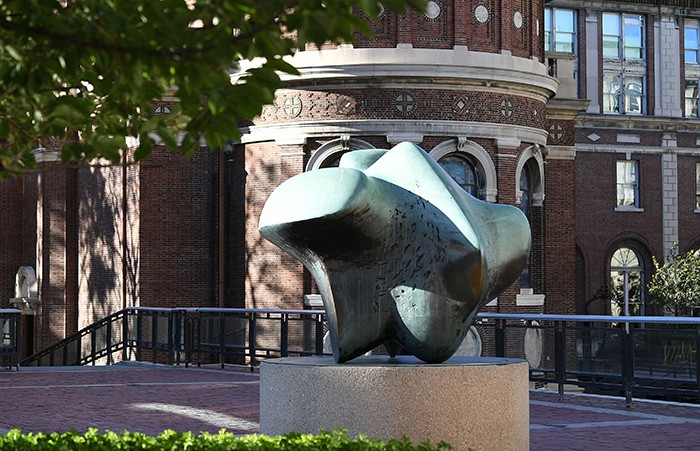
Continue your turn counterclockwise around the grassy area on Revson Plaza and you will find Three-Way Piece, No. 1: Points, by famed sculptor Henry Moore (1898-1986), who is known for his monumental, abstract bronzes, including #6 below.
Three sculptures of Three-Way Piece, No. 1: Points were cast in 1967 and the sisters of this piece exist at the Des Moines Art Center and Fairmount Park in Philadelphia.
"My idea was to make a new kind of sculpture, less dependent on gravity, which could be seen in at least three positions and be effective in all of them; a sculpture which you could understand more completely because you know it better," Moore said of the work.
3d. Tightrope Walker
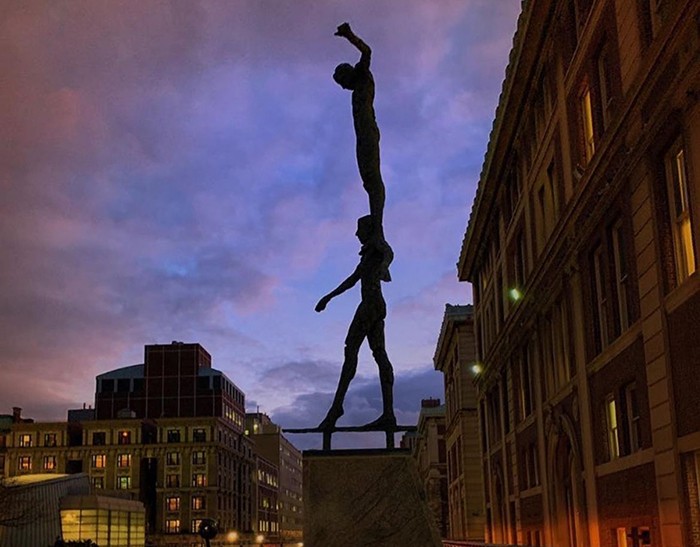
If you continue your turn about the green space on Revson Plaza, as you face St. Paul's Chapel, you'll see another fascinating work straight ahead of you: Tightrope Walker. Designed as a tribute to General William J. "Wild Bill" Donovan, a graduate of Columbia College and Columbia Law School, Tightrope Walker was created by the Dutch artist Kees Verkade and installed on Revson Plaza in 1979.
The bronze sculpture shows two tightrope walkers, one balancing atop the other’s shoulders. Weighing in at 842 pounds, it stands at 21 feet tall including its stand. You can learn more about the sculpture and who it is dedicated to, from Art Properties.
4. Le Marteleur (The Hammersmith)
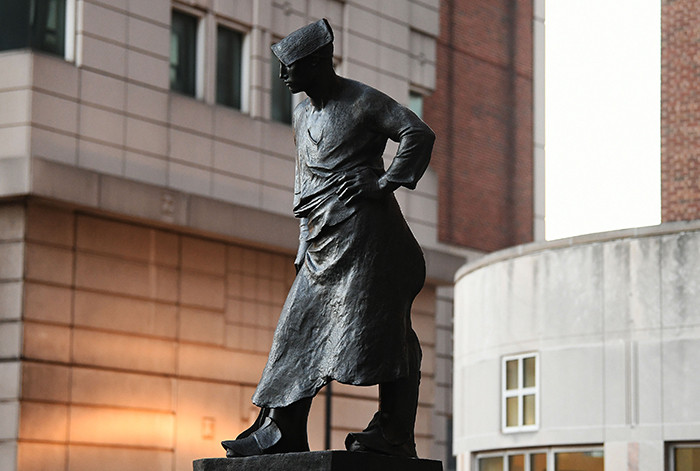
Exit Revson Plaza to your right and walk straight ahead. You'll wave once more to The Thinker on your left, then turn right on the walkway leading down the side of Low Library. You'll pass Curl on your left (and don't worry, we'll be back!), but continue walking forward until you reach the intersection of Mudd and Fairchild halls where Le Marteleur (The Hammersmith) stands.
First modeled around 1884, this sculpture is by the Belgian artist Constantin Meunier (1831-1905), who became famous in his day for figures that idealized the image of the worker or laborer, according to Art Properties.
"Although Meunier’s figure wears the clothing and holds the accessories of an industrial metalworker, he stands in classical contrapposto," Ferrari writes. "The idealization of the worker’s body shows this figure is a modernist reinterpretation of the neoclassical gods and heroes in marble that were popular earlier in the 19th century."
Le Marteleur was a gift from the Class of 1889 School of Mines, now the Fu Foundation School of Engineering and Applied Sciences, and was first installed in front of the School of Mines (then in Lewisohn Hall) in 1914.
5. Curl
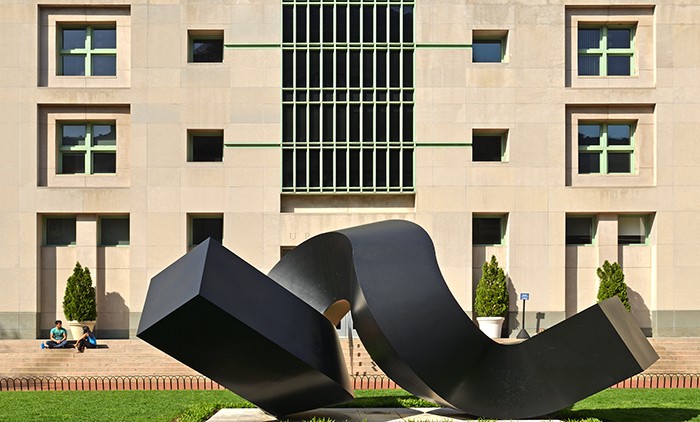
Retrace your steps back to the front of Uris Hall and behold Clement Meadmore's (1929-2005) Curl. Meadmore received training as a sculptor in Australia, but moved to the United States in the 1960s, where he was influenced by Abstract Expressionism, Minimalism, and the improvisational sounds of jazz, according to Art Properties.
Installed in 1968, the sculpture was commissioned by Percy Uris (1899-1971), a benefactor of Columbia Business School, whose name adorns Uris Hall. It was Meadmore's first large-scale commission, and he went on to receive many other commissions for public outdoor sculptures from universities, corporations, and cities around the world. In 2015, the sculpture underwent extensive conservation, which you can read about here.
Turn westward from Curl and you'll see another iconic Columbia sculpture: Scholars' Lion by Gregg Wyatt, which was unveiled in 2004 after being commissioned by the Class of 1996.
6. Reclining Figure
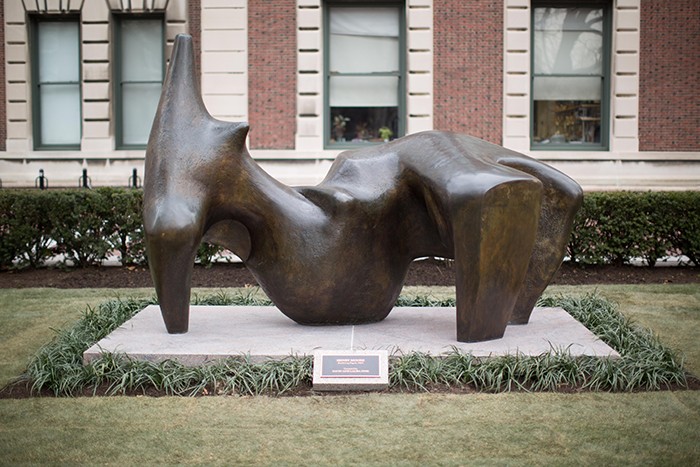
Look directly behind Scholars' Lion, in front of Havemeyer Hall and Mathematics, and you'll see another, more recent Henry Moore sculpture: Reclining Figure.
David and Laura Finn generously donated the sculpture in 2016, but it was originally cast with five other full-size copies in 1969 and 1970, possibly representing a woman resting on one side of her body,
7. The Great God Pan
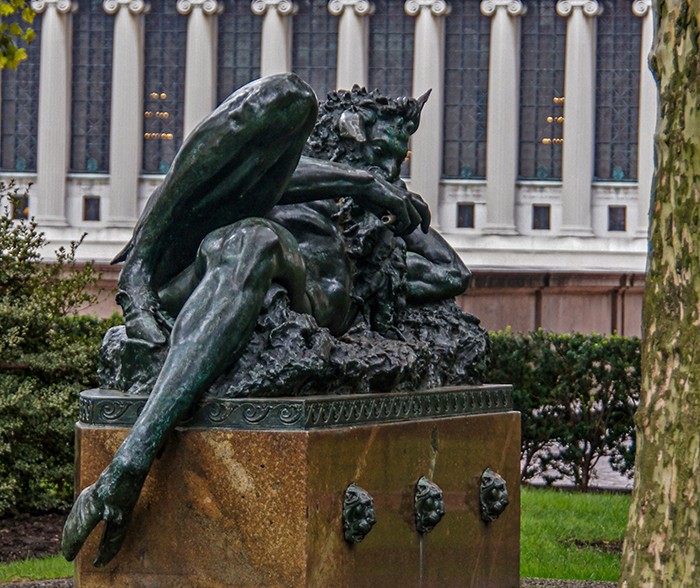
From Havemeyer Hall, continue your turn about Columbia's Morningside campus counterclockwise until you pass Earl Hall on your right. Standing on the lawn across from Lewisohn Hall, you'll find George Grey Barnard's (1863-1938) sculpture The Great God Pan.
"The work shows the Greek god Pan in his usual form as half-man, half-goat, playing the pan pipes associated with him," Ferrari writes. "As a fertility deity, he is often accompanied by fauns and nymphs, but here he is seen in solitude enjoying the music he plays."
The sculpture has a rather scandalous past: Originally commissioned in the mid-1890s for the Dakota apartment building on 72nd St. and Central Park West, it was deemed too lustful. It might have ended up in Central Park, but Edward Severin Clark donated it to Columbia where it was originally installed as a part of a working fountain and grotto in the northeast corner of the Morningside campus.
Another reason you might know the sculptor's name? Over his life, he collected medieval architectural fragments and sculptures, which eventually became the foundation for The Cloisters Museum & Gardens at The Metropolitan Museum of Art, according to Art Properties.
8. Spirit of the Greek Games
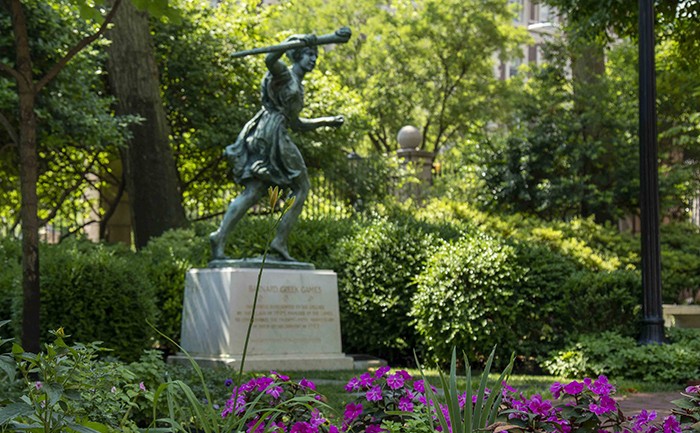
After gandering at Pan, exit campus through the Earl Hall Gate, cross Broadway, and enter the Barnard College campus. To your right, you'll find Chester Beach's (1881-1956) The Spirit of the Greek Games.
RELATED CONTENT
Also known as Torch Bearer, this sculpture was given to Barnard by the Class of 1905, the founders of the Greek Games, to commemorate the 25th anniversary of the games. You can read more about the statue's significance here, from Barnard College.
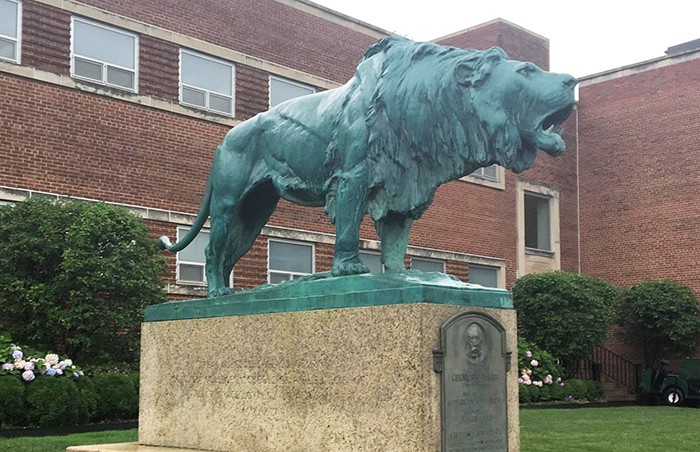
From Barnard College, we're going to take a little journey northward on the 1 Train, to Baker Athletics Complex, 505 West 218th Street. Here, we find The Lion Hath Roared by Frederick G. R. Roth in front of Chrystie Field House. The bronze sculpture was donated by the Class of 1899 as their 25th anniversary class gift in 1924.
This is but a small sampling of sculptures you can find at Columbia. We encourage you to wander and discover even more. And stay tuned for a walking tour of different indoor art pieces that you can find across Columbia's campuses.